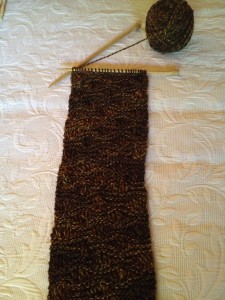 Don’t underestimate the power of technology to improve your consciousness, your thinking and your actions.
Don’t underestimate the power of technology to improve your consciousness, your thinking and your actions.
Ever since I started using the app Lift earlier this year to help me track my habits, it’s much easier for me to remember to practice “SCARF” in two different contexts.
One is the ancient practice of knitting, which for me generally means working on a scarf. Ever since my husband and I took a class last year, I try to knit at least twice a week so I don’t lose my new skill. I’ve designated “knitting” as a habit in Lift to help me track my progress.
The other habit is using the brain-based SCARF model developed by David Rock, CEO of the NeuroLeadership Group.
SCARF is designed to improve your collaboration and influencing skills not just in the workplace, but in any setting in which you’re interacting with individuals.
While I haven’t recorded SCARF explicitly in the Lift app, seeing the knitting habit prompts me to watch my words and actions on a daily basis so I don’t accidentally threaten people. This helps me work and play better with others. (Full disclosure: Since I’m now an associate with the NeuroLeadership Group, I really need to model the model! I know I’m not perfect though….)
SCARF stands for Status, Certainty, Autonomy, Relatedness and Fairness.
These are the five key domains of human social experience that can activate a threat or reward response in an individual, often with the same intensity as a physical threat or reward. For example, smelling smoke and hearing a sincere “thank you” can both trigger intense responses.
(For more about the neuroscience, see the research paper Pains and pleasures of social life by Naomi Eisenberger and Matthew Lieberman from www.sciencemag.org.)
In the SCARF model:
- Status is about one’s relative importance to others.
- Certainty relates to being able to predict the future.
- Autonomy provides a sense of control over events.
- Relatedness is a sense of safety with others.
- Fairness is a perception of fair exchanges between people.
The model’s memorable name helps you become aware of your unconscious thoughts and actions.
By bringing them to consciousness, the SCARF model encourages you to think how certain words and actions may feel threatening to others. You then can figure out better ways to minimize others’ fears, and even better, motivate them.
According to the neuroscience on which the SCARF model is based, we feel threatened more frequently and more intensely than we feel rewarded.
Worse, when we feel threatened, we aren’t able to make decisions, solve problems and collaborate with others as well as we can when we’re in a positive reward state.
For me, the power of the SCARF model is a one-two punch.
First, learning about the model, including recognizing how easy it is to accidentally threaten—or “SCARF”—individuals, has confirmed for me that the workplace is packed with booby traps and other barriers for the brain. It’s amazing we accomplish as much as we do.
Second, taking the free self-assessment has increased both my self-awareness and empathy.
The assessment has helped me understand my triggers better, as well as think more carefully about how others might react to my requests and comments. By better anticipating their possible reactions, I’m more likely to avoid threatening them. I also can improve and possibly motivate them.
Thanks to the self-assessment results, I know the order in which the five SCARF drivers matter most to me.
(Like many people I’ve talked and worked with, I was surprised by the results. “Certainty” is my top driver, which I didn’t expect because I’m a change junky—except when it comes to scheduling. I now know why my always-in-flux calendar can make me cringe. Now I tell myself to roll with the punches. This self-regulation and reappraisal keeps me more positive.)
As for dealing with others, here are some examples of recent actions I’ve taken to reduce the possibility of them feeling threatened and increase their chances of feeling rewarded.
- Status: Including individuals’ titles on agendas when most of the meeting participants are proud of their advanced degrees and titles.
- Certainty: Helping clients identify very tiny steps they can take to start achieving their big goals.
- Autonomy: Co-creating at least two options that can work to address an issue or problem and letting others decide.
- Relatedness: Taking time to get to know people and build rapport before jumping into the work.
- Fairness: Being transparent in how I work and set fees, and getting people more involved in the work.
If you want to learn more about the SCARF model and its power, visit this website. You also are welcome to ask me questions.
I won’t try to convert you as I don’t want to threaten you. I’ll just conclude by saying using the SCARF model and knitting are very rewarding habits!

Really Practical and helpful. Thank you.